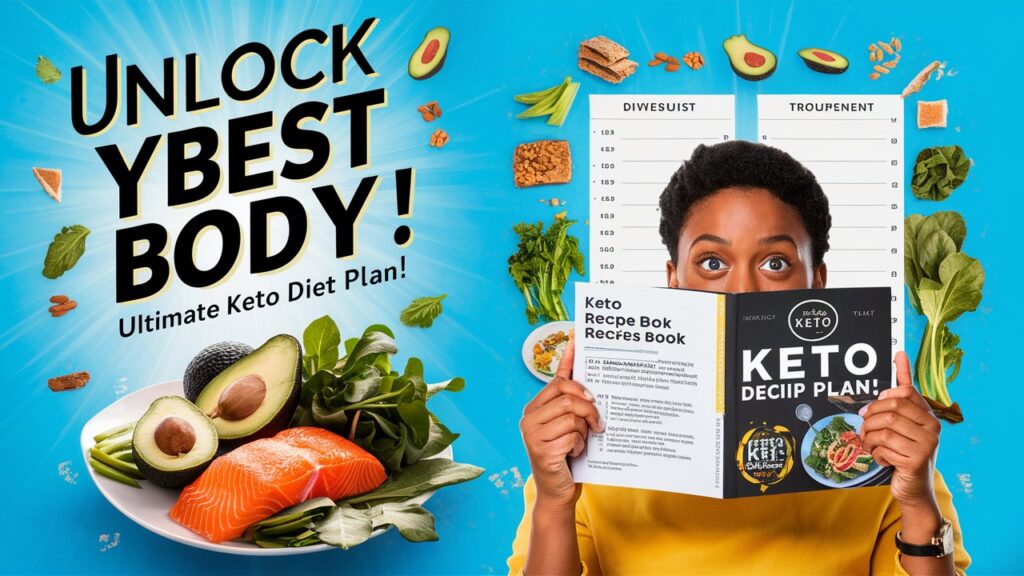Keto Diet Plan: Simple Steps for Effective Results:

The keto diet has taken the health and fitness world by storm, and for a good reason. But what exactly is it? The ketogenic diet, commonly known as the keto diet, is a low-carb, high-fat diet designed to put your body into a state of ketosis. This metabolic state is where your body becomes incredibly efficient at burning fat for energy. In this article, we’ll break down the ultimate keto diet plan, guiding you through simple steps to achieve effective results.
Understanding the Basics
What is Ketosis?
Ketosis is a natural metabolic state where your body burns fat instead of carbohydrates for fuel. This happens when you significantly reduce your carb intake, forcing your body to tap into its fat stores for energy. The result? Increased fat burning and weight loss.
How Does the Keto Diet Work?
By drastically reducing your carbohydrate intake and replacing it with fat, your body enters ketosis. Typically, this means consuming about 70% of your daily calories from fat, 20% from protein, and only 10% from carbs. This macro distribution is key to maintaining ketosis and reaping the benefits of the keto diet.
Benefits of the Keto Diet
- Weight Loss: The keto diet is highly effective for weight loss, particularly in the initial stages.
- Improved Mental Clarity: Many people report enhanced focus and mental clarity while in ketosis.
- Stable Energy Levels: Unlike the energy spikes and crashes that come with high-carb diets, keto offers steady energy throughout the day.
Essential Components of a Keto Diet
High-Fat Foods
The foundation of the keto diet is high-fat foods. Think avocados, nuts, seeds, olive oil, and fatty fish like salmon. These foods provide the necessary fat to keep your body in ketosis.
Low-Carb Vegetables
Vegetables are a crucial part of any healthy diet, and keto is no exception. Focus on low-carb options like spinach, kale, broccoli, and cauliflower. These vegetables are nutrient-dense and won’t kick you out of ketosis.
Proteins in Moderation
While protein is important, too much can interfere with ketosis. Stick to moderate portions of high-quality protein sources like eggs, chicken, and grass-fed beef.
Getting Started with the Keto Diet
Setting Realistic Goals
Before diving into the keto diet, it’s essential to set realistic goals. Are you looking to lose weight, improve mental clarity, or enhance your athletic performance? Defining your goals will help you stay focused and motivated.
Calculating Your Macros
Understanding your macronutrient needs is crucial for success on the keto diet. Use a keto calculator to determine your ideal intake of fats, proteins, and carbs based on your goals, age, weight, and activity level.
Importance of Meal Planning
Planning your meals in advance is one of the best ways to ensure you stick to the keto diet. Prepare a weekly menu that aligns with your macros and includes a variety of foods to keep things interesting.
Creating Your Keto Meal Plan
Sample Breakfast Options
Start your day with a high-fat, low-carb breakfast like scrambled eggs with avocado or a chia seed pudding made with coconut milk. These meals are filling and help maintain ketosis.
Keto-Friendly Lunch Ideas
For lunch, consider a salad with mixed greens, grilled chicken, avocado, and olive oil dressing. Or try a lettuce-wrapped burger with cheese and bacon for a satisfying meal that fits your keto plan.
Dinner Recipes for Keto Dieters
Dinner on keto can be both delicious and simple. Think grilled salmon with a side of asparagus or a creamy cauliflower mash paired with a juicy steak.
Snack Options on Keto
Snacking can be tricky on keto, but with the right options, you can satisfy your cravings without breaking ketosis. Consider nuts, cheese, or a small portion of dark chocolate as keto-friendly snacks.
Common Mistakes to Avoid
Not Eating Enough Fat
One of the most common mistakes on keto is not consuming enough fat. Remember, fat is your primary fuel source on this diet, so don’t skimp on it.
Ignoring Electrolyte Balance
Electrolyte imbalances are common in the early stages of keto. Make sure to consume enough sodium, potassium, and magnesium to avoid symptoms like headaches and fatigue.
Overeating Processed Keto Foods
Processed foods labeled as “keto-friendly” can be tempting, but they’re often loaded with unhealthy fats and additives. Stick to whole, unprocessed foods whenever possible.
Keto Diet for Different Lifestyles
Keto for Vegetarians
Vegetarians can also thrive on a keto diet with some adjustments. Focus on high-fat plant-based foods like nuts, seeds, and avocados, and consider incorporating eggs and dairy for added protein.
Keto for Busy Professionals
If you’re short on time, meal prepping can be a lifesaver. Prepare keto-friendly meals in bulk, so you always have something ready to eat during your busy week.
Keto for Athletes
Athletes may need to adjust their keto diet to ensure they get enough energy for their workouts. This might include strategically timing carb intake around training sessions.
Adjusting to the Keto Lifestyle
Coping with the Keto Flu
The “keto flu” is a common experience for those new to the diet, characterized by symptoms like fatigue and irritability. Stay hydrated and replenish electrolytes to ease these symptoms.
Tips for Staying Consistent
Sticking to the keto diet can be challenging, especially in the beginning. Keep your goals in mind, track your progress, and don’t be afraid to experiment with new recipes to keep things exciting.
Social Situations and Eating Out
Navigating social situations while on keto can be tricky, but it’s not impossible. Opt for low-carb options at restaurants, and don’t hesitate to ask for modifications to fit your diet.
Monitoring Progress and Staying Motivated
Tracking Ketosis Levels
You can track your ketosis levels using urine strips, blood tests, or breath analyzers. Monitoring your progress can help you stay motivated and make adjustments as needed.
Celebrating Small Wins
Every step forward is a success. Whether it’s losing a few pounds or successfully sticking to your meal plan, celebrate your achievements to stay motivated.
Adjusting the Plan as Needed
The keto diet isn’t one-size-fits-all. If something isn’t working for you, don’t be afraid to tweak your plan. Whether it’s adjusting your macros or incorporating more carbs, find what works best for you.
Supplements to Support Your Keto Journey
Electrolytes and Hydration
Electrolytes are crucial on keto, especially in the beginning. Consider supplementing with sodium, potassium, and magnesium to avoid imbalances.
Exogenous Ketones
Exogenous ketones can help boost your energy levels and enhance mental clarity, especially during the transition to ketosis.
Essential Vitamins and Minerals
While the keto diet is rich in many nutrients, you might still need supplements like vitamin D, omega-3s, and magnesium to ensure you’re meeting all your nutritional needs.
Exercise and the Keto Diet
Best Workouts to Complement Keto
High-intensity interval training (HIIT), weightlifting, and low-intensity cardio are all great workouts to pair with the keto diet. These exercises help enhance fat burning and build lean muscle.
Pre- and Post-Workout Nutrition
Pre-workout, consider a small amount of protein and fat to fuel your session. After your workout, replenish your body with a keto-friendly meal that includes a balance of fats and protein.
Potential Side Effects and How to Manage Them
Short-Term Side Effects
In the short term, you might experience side effects like the keto flu, constipation, or bad breath. These usually resolve as your body adapts to the diet.
Long-Term Considerations
Long-term keto can lead to nutrient deficiencies if not carefully managed. Make sure you’re eating a varied diet and consider periodic blood tests to monitor your health.
Long-Term Success on the Keto Diet
Transitioning from Weight Loss to Maintenance
Once you’ve reached your weight loss goals, you might want to shift to a maintenance phase. This could involve slightly increasing your carb intake while maintaining a low-carb, high-fat approach.
Sustainable Keto Habits
For long-term success, focus on building sustainable habits. This includes planning meals, staying active, and listening to your body’s needs.
Understanding When to Reintroduce Carbs
Reintroducing carbs should be done gradually and mindfully. Start with whole, unprocessed carbs like sweet potatoes or quinoa, and monitor how your body responds.
The keto diet can be a powerful tool for weight loss, mental clarity, and overall health. By understanding the basics, setting realistic goals, and avoiding common mistakes, you can achieve long-term success. Remember, the key to any diet is consistency and balance. Whether you’re just starting or looking to refine your approach, the ultimate keto diet plan is within your reach.
- Also Read :
- Release Trauma with Somatic Exercises Today!
- Discover Somatic Exercises for Effective Weight Loss
- Strengthen Your Lower Back with These Gym Equipment
- How Did Kelly Clarkson Lose Weight? Her Secrets Revealed
- 10 Effective Couples Therapy Exercises for Stronger Bonds
- What are some fun and challenging exercises for a couples workout routine
- Transform Your Relationship with a Couples Diet & Exercise Plan
FAQ’S:
What is the Best Time to Start the Keto Diet?
The best time to start the keto diet is when you’re ready to commit to a lifestyle change. Preparation is key, so take time to plan your meals and understand the diet before you begin.
Can I Drink Alcohol on Keto?
Yes, but choose low-carb options like dry wine or spirits. Be mindful of mixers and limit your intake to stay within your carb limits.
How Fast Will I See Results on Keto?
Results vary depending on your goals and adherence to the diet. Some people see weight loss within the first week, while others may take longer to notice changes.
Is Keto Safe for Everyone?
Keto is generally safe for most people, but it’s always best to consult with a healthcare professional before starting any new diet, especially if you have underlying health conditions.
